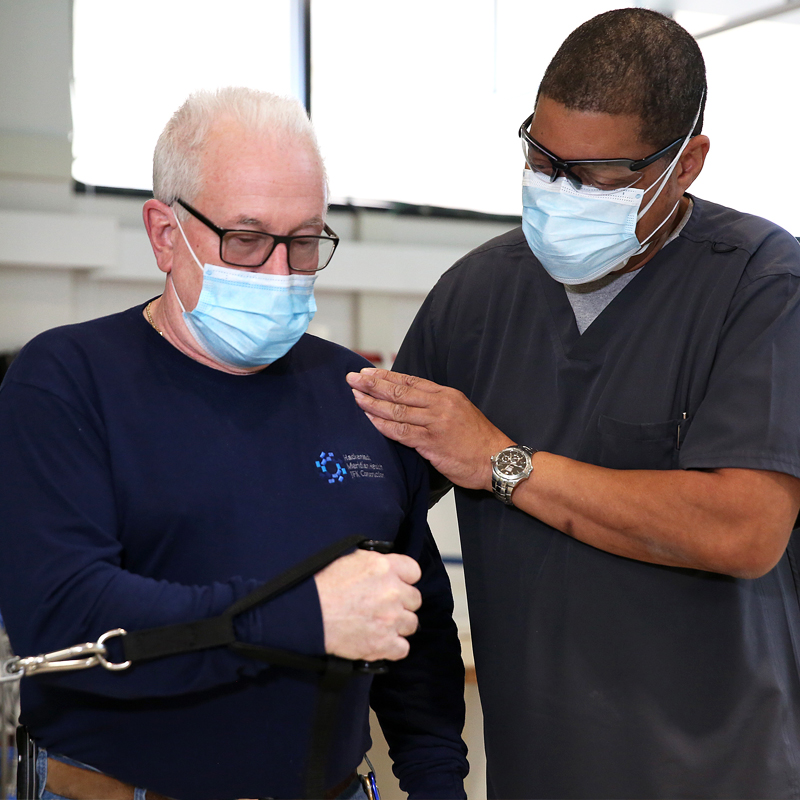Rotator Cuff Pain: How to Treat It And What Are My Treatment Options?

November 12, 2019
Each year, nearly 2 million people in the United States see a doctor about shoulder pain due to a rotator cuff injury, according to the American Academy of Orthopaedic Surgeons. The rotator cuff is a group of four muscles—one in the back (teres minor), one in the front (subscapularis) and two on top (supraspinatus, infraspinatus)—that surround the shoulder’s ball-and-socket joint and keeps the ball balanced in the shoulder socket. It’s one of the most complex joints in the body, as it also has the most range of motion.
What Causes Rotator Cuff Pain?
Rotator cuff pain and injuries can happen to anyone, not just athletes. Baseball players or volleyball players put a lot of repeated strain on their shoulders and often develop problems. A traumatic blow to the shoulder can happen to anyone, causing severe pain and a possible tear in one of the rotator cuff muscles.
Chronic pain can happen to people whose jobs demand constantly reaching overhead or lifting heavy items. Degeneration of the rotator cuff can also happen naturally as we age.
Where Are You on the Rotator Cuff Pain Scale?
“It’s a very complicated part of the body that we still don’t have all the answers to,” says Siddhant Mehta, M.D., Ph.D, a shoulder and elbow surgeon at Hackensack University Medical Center and Palisades Medical Center. As an expert in shoulder and elbow surgery, he notes, “Some people with full rotator cuff tears have no pain and no other symptoms, so it goes to show that not all rotator cuff tears should be treated the same.”
Chronic shoulder pain can occur due to a spectrum of conditions involving the rotator cuff.
At one end are conditions like impingement, bursitis and tendonitis, in which the cuff tendons are reversibly affected.
On the other end of the spectrum are conditions like tendinopathy, partial-thickness tears and full-thickness tears which irreversibly affect the cuff tendons.
In massive rotator cuff tears that are left untreated, arthritis of the shoulder joint can occur, and this is known as rotator cuff arthropathy. The hallmarks of cuff-based pain include pain that occurs with overhead activity, reaching out to the side or reaching behind the back. Often, the pain may also occur at rest and at night, can radiate into the upper arm and can be associated with weakness.
Acute traumatic rotator cuff tears occur due to an injury and should be evaluated in a timely manner.
What Are Your Treatment Options?
“There are several factors that I take into account when managing rotator cuff disease. First is distinguishing acute traumatic injuries from chronic degenerative cuff disease. Further, the patient’s age, hand dominance, activity level and occupation help me tailor a treatment that is most suitable for that patient,” Dr. Mehta says. “We want to maximize non-surgical treatment if possible, so unless there was a traumatic accident or sudden injury to the shoulder, we try to start slowly at first.”
Conservative therapies for rotator cuff disease include:
- Non-steroidal anti-inflammatory medications
- Activity modification to decrease inflammation. “If you lift weights, take a break, for instance,” Dr. Mehta says. “Pay close attention to what you’re doing when the pain occurs, and try to avoid that movement for a while, if possible.”
- Physical therapy to work on range of motion, stretching and light rotator cuff conditioning
Corticosteroid injections to reduce inflammation and provide pain relief. Dr. Mehta suggests no more than three of these injections a year.
If Surgery Is Your Only Option
If surgery is your only option, know that recovery from rotator cuff surgery is among the most painful. “Patients are shocked when I tell them that, but I’d rather let them know ahead of time so they’re prepared,” Dr. Mehta says.
Surgical management for most rotator cuff tears is usually an outpatient procedure during which shoulder surgeons use arthroscopic techniques to make three to five small incisions around the shoulder. Using a camera and tiny instruments, surgeons clean up and repair the cuff.
Afterward, you’ll have to keep your arm immobilized in a sling for six weeks. The entire recovery takes about four to five months.
In massive tears that have progressed to arthritis and rotator cuff arthropathy, a reverse total shoulder replacement is usually performed. This is a more complex procedure that should be performed by a trained shoulder surgeon and involves an open surgery in which the arthritic areas are cut and the ball and socket articulation is “reversed,” allowing the shoulder to function without a rotator cuff.
“What patients need to understand is surgery is not always the answer. There’s no one algorithm we can use to treat every patient with rotator cuff dysfunction,” Dr. Mehta says. “Each case is unique, and we have to treat our patients accordingly.”